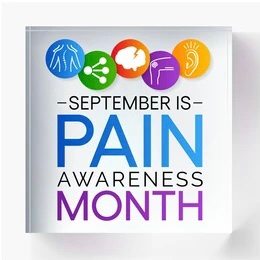
National Pain Awareness Month is observed in September every year. Pain professionals and activists from all around the country get together to raise awareness about problems connected to chronic pain during this month. Chronic pain directly impacts millions of people in the United States.
Pain Awareness Month was established in 2001 by a consortium of organizations coordinated by the American Chronic Pain Association (A.C.P.A.). These organizations, which included the American Cancer Society and N.A.A.C.P., came together under the auspices of the ‘Partners for Understanding Pain initiative.’ Since then, the initiative has grown into what it is today, where healthcare practitioners work to inform their communities of what chronic pain is, how it can happen and be avoided and what to do if you suffer with chronic pain.
Chronic pain is defined as pain that lasts for three months or more, and in certain circumstances, the neural system remains hyperactive after the original injury or sickness has healed. Chronic pain is often the result of an initial injury, such as muscular strain and it can also remain and intensify due to a nerve injury, which intensifies and prolongs the agony.
Many people go to see their regular doctor when they have pain. Many more go to the emergency room. But the treatments received don’t always provide relief. Everything from pain pills to surgery may be suggested to help pain sufferers. And because of over-prescribing pain medications, there is a major epidemic in the United States. Opioids, one class of prescription painkillers, has turned into a legitimate killer, causing more and more people to die. It is estimated that nearly 2.1 million people in the U.S. are suffering from substance abuse disorders that are directly related to opioid pain relievers (National Institute on Drug Abuse).
This is where acupuncture comes in. Acupuncture, a modality within the East Asian Medicine system, uses hair-thin needles to stimulate specific pressure points on the body. By invigorating these points, the brain is triggered to release endorphins, which are natural painkillers. The energy within the body is also moved and adjusted. This energy is called qi (pronounced “chee”) in East Asian Medicine. According to EAM medical theory, when the qi is blocked or weak, then pain and illness can attack the body.
One of the advantages of utilizing acupuncture to treat pain is that the acupuncturist doesn’t need to diagnose the cause of the pain before treating it. Licensed acupuncturists look at a person holistically, taking into account the state of their gut, mind and physical body. This is why East Asian Medicine can’t be defined in the same context as conventional allopathic medicine. And since acupuncture has no real adverse side effects when performed by a qualified and professionally licensed practitioner, pain relief can begin the very first time a patient is treated.
The treatments are also very customizable because this medicine is not a “one size fits all” type of solution. This means that as the pain shifts and changes, the patient will receive customized treatments that not only address the pain and inflammation, but they also work on resolving the root of the problem. Most patients who are dealing with pain also have added stress, insomnia, depression or anxiety, metabolism issues and more. Acupuncture is great at treating all of these conditions. So the patient gets more than just pain relief with every treatment.
Acupuncture is so effective at treating and relieving pain that it is now showing up in hospitals and emergency rooms. In fact, Abbott Northwestern Hospital in Minneapolis, Minnesota is now successfully using acupuncture in its emergency room to treat conditions ranging from car accident injuries to kidney stones. Their initial results show that pain scores are just as low with acupuncture as they are with those that are given analgesic painkillers. Another positive action regarding the utilization of acupuncture came just recently. The Food and Drug Administration released proposed changes that plan to educate health care providers about treating pain. The new guidelines recommend that doctors get information about acupuncture and suggest it to their patients before prescribing opioids.
With these kinds of recommendations and testimonials, it is hard to believe that only about ten percent of Americans have ever tried acupuncture. But that statistic is slowly changing as more and more people are seeking natural and alternative methods of dealing with pain. Treating pain is one of the most common reasons that people come into the office. And for many people, pain relief can be achieved fairly quickly in just a few treatments. To find out more about how acupuncture can help you during National Pain Awareness Month, give us a call. We’re here to serve you.

